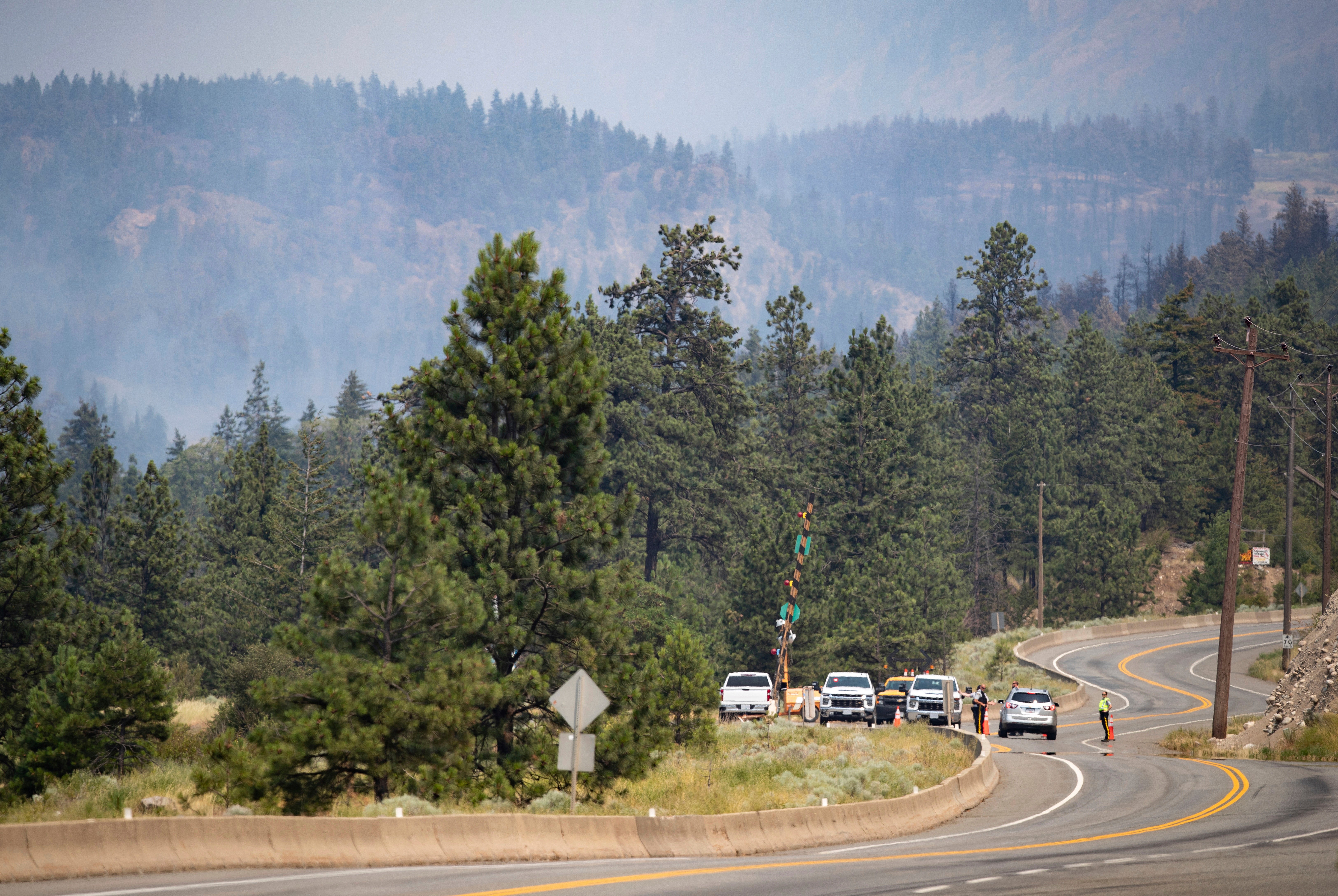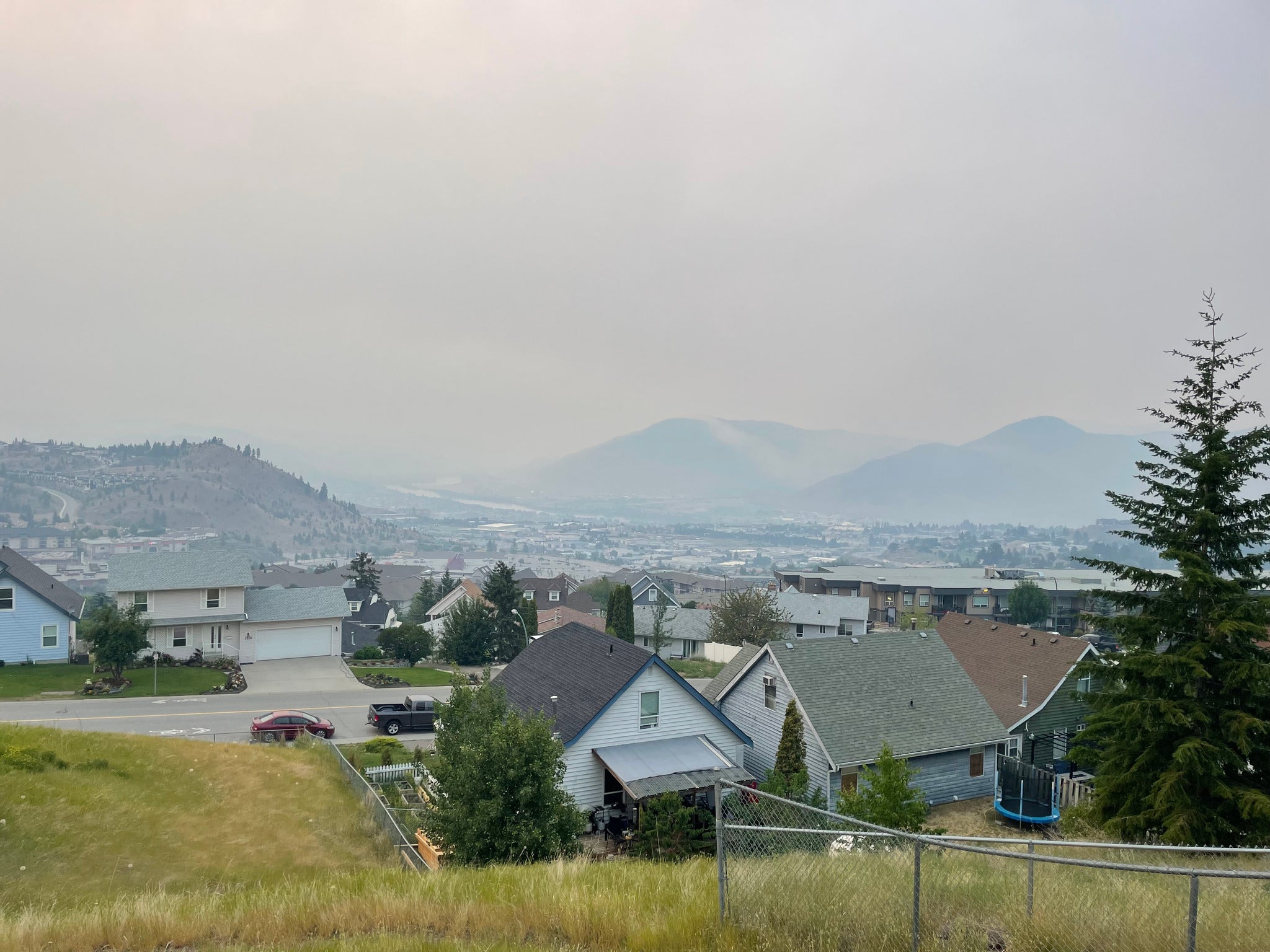‘The biggest fire season we’ve ever seen’: Fire-ravaged British Columbia braces for more after deadly Lytton blaze
A village was all but destroyed by fire, but that may just be the beginning, writes Ashleigh Stewart in Kamloops


As firefighters across Canada’s British Columbia battle almost 200 blazes across the province, authorities are bracing for one of the most severe fire seasons in years.
Currently, 172 fires of varying sizes are burning across BC, with 60 situated in the Kamloops Fire Centre, where the town of Lytton was all but destroyed by a fire on Wednesday evening.
Thick smoke envelops huge swathes of the Thompson-Nicola Regional District, a mountainous region in BC’s interior, as wildfires rage out of control and threaten homes and communities nearby.
In Kamloops, the district’s main population centre and home to 90,000 people, the wildfire smoke is so thick the mountainous landscape is obscured by the haze, and the air quality has been deemed a “very high health risk”.
Two major wildfires are burning out of control to the northeast and southwest of Kamloops, one of which, at Sparks Lake, has grown to 36,000 hectares.
The blaze grew significantly in size on Sunday evening, according to the BC Wildfire Service, and had so far forced the evacuation of 163 homes. A further 298 homes are on evacuation alert.
Wildfire season in British Columbia starts in April and lasts until October, however, most significant fires tend to flare up in the hotter months of late July and August — meaning this year’s earlier start has put authorities on high alert for a prolonged, and potentially more severe, season.
On Wednesday, the village of Lytton was all but destroyed by a fire, just days after it broke the record for Canada’s all-time highest temperature for three days in a row, reaching 121.1F (49.5C).
Meteorologists say the unprecedented conditions are being caused by a “heat dome” over western Canada and parts of the US Pacific northwest.
A heat dome is an unofficial term given to an area of hot air high up in the atmosphere which lingers over an area for a prolonged period of time, trapping in heat below.
However, while initial reports suggested Lytton had been razed by a wildfire burning nearby at Lytton Creek, BC Premier John Horgan says that was not the case.
An official cause was now being investigated, and while social media rumours suggested the fire may have been sparked by a passing train, Thompson-Nicola Regional District chief administrative officer Scott Hildebrand says this was “certainly not our view”.
“That information is unconfirmed and we are investigating,” Hildebrand says.
“I do know for a fact though, that the fire in Lytton had nothing to do with the wildfire that was in that area.”
An estimated 1,000 evacuees from Lytton had sought refuge in neighbouring towns, but the speed at which the fire ripped through the community meant there was no set evacuation plan, leaving residents scattered across a number of nearby towns. Authorities are still working to identify how many people are still missing, while the BC Coroner’s Service has confirmed two deaths.
Lytton, and large swathes of the surrounding area, remain cordoned off and may be for some time. However, Hildebrand is working on organising buses to transport residents back into the town so they can survey the damage in “a safe and controlled method”.
“It’s a devastating situation… and they need to grieve and to see what happened in their community,” he says.
Thousands of lightning strikes in BC over the last few days – exacerbated by the hot smoke and ash in the atmosphere - have ignited dozens of new wildfires.
The Kamloops Fire Centre was battling the majority of the region’s blazes, with 60 in their jurisdiction. Four of these were considered “really significant”, Noelle Kekula, fire information officer, says.

On Thursday night, a fast-growing wildfire led to residents of several Kamloops neighbourhoods being evacuated from their homes. However, within a few hours, this was rescinded as rain started to fall in the area. The forecast for the coming days in the region does not seem to offer any relief. Other than a brief chance of rain on Thursday, Kamloops looks set for a hot and sunny week, with the chance of more lightning storms.
Due to the thick clouds of smoke enshrouding the town, the Air Quality Health Index in Kamloops is now 10+, which is the highest the scale goes, and is considered “very high risk” to people’s health.
Hildebrand urged people in the town to “protect themselves and stay indoors, and wear masks”.
He says the current scale of wildfires indicated this year’s fire season could last longer than usual, and his team was “preparing for the worst and hoping for the best”.
Fire crews currently fighting the region’s fires share the same fears.
Jeff Mayse, a firefighter with Strategic Wildfire, a private firefighting company, had been battling a 50-hectare blaze near the town of Hope, just south of Lytton.
His crew extinguished the last patch of that fire on Friday.
“Today was the best day of my firefighting career. If I never put out another fire again I won’t care. Putting that last little patch of fire out was amazing.”
However, Mayse was primed for a busy few months. He says the conditions this year were “extreme”.
“We’re in for the biggest fire season this province has seen,” he says. “Part of me longs for October, because there’s a long road between here and there.”
Mayse says June tended to be a month of little fire activity, nicknamed “Junesies” as most firefighters would be “sitting around bored, because it’s raining”.
Last year, his crew didn’t have a single call-out for a fire. In 2019, they had a handful. However, 2017 and 2018 were significant years for large fires, so Mayse wasn’t sure whether this years were due to an altered climate or the cyclical nature of fires.
Mike Kucey, who works in operations at BC’s Coastal Fire Centre, says “every few years we have a really big season and this is going to be that year”.
“The temperatures are the unprecedented part, I’ve never seen temperatures like this.”
The season had begun two to four weeks early, Kucey says, and had come on “extremely fast, within about a week”.
“Right now we’re in full-scale fire season in early July. It’s unheard of,” Kucey says.“We’re in for a very fast, hot, dry hot summer and a prolonged fire season.”
Arjun Singh, Kamloops city councillor and deputy mayor, says while the town was “well versed in all of this stuff”, this was a “very concerning time” for the city.
“Lytton was a very sobering event for all of us,” he says. “This community as a whole is resilient, but also anxious.”
Singh says residents should have an evacuation bag ready, and refrain from any activity that could spark a fire - from throwing cigarettes out a car window, to even riding a motorbike. Campfires are currently banned throughout BC.
“We have to remain very vigilant. We’re watching fires happen more quickly and more unpredictably than ever before and climate change is playing a big part of that.”
Hildebrand agrees. While his focus was on the immediate response right now, he acknowledged that questions would need to be posed about the role of global warming in this event.
“Climate change is something we all have to understand and deal with and prepare for. It is part of the story in my opinion. This is something we’ll have to deal with when we come out of this.”


Join our commenting forum
Join thought-provoking conversations, follow other Independent readers and see their replies
Comments